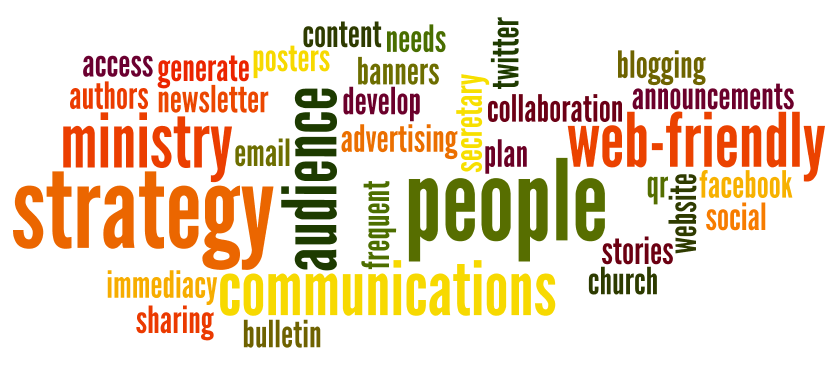Web-friendly Communications Strategies for Churches
In many churches, communicating via the church website, social networks, or email is an afterthought. Operating without a developed strategy is not unlike the clueless marketing director in the cartoon who simply either shouts out his message or hopes someone will show interest in his company. Consider the following two churches, and ask yourself which one yours is most like.
Exhibit A: Church of Lifelong Hope
First Church has a church secretary who is responsible for almost all church communications. The weekly bulletin announcements contain announcements about events in the next two to three weeks. Most of these announcements are printed without a corresponding image (but those images that do get added are typically cheap clip-art), and their content gets duplicated in the monthly church newsletter.
The newsletter is written first-and-foremost with church “regulars” in mind. It contains events that will take place within about the next four to six weeks, a note from the pastor, some prayer joys and concerns, registration or order forms, and some miscellaneous items. The articles are written primarily by the pastor and any other staff people as well as any team leaders who remembered the newsletter deadline. The essentials are generally covered: what, where, and when, plus a bit of the who and why. Oh, and there is, of course, a printed calendar of events for members to put on their fridge.
One or more church bulletin boards contain other news, such as fliers sent to the church by other community groups. The occasional poster promoting some significant church event can be found there, and maybe some photos or news clippings as well.
The church website, which was created by a volunteer a year or two ago, usually gets a PDF copy of the church newsletter uploaded to it on or about the same day it arrives in church members’ mailboxes. Otherwise, no news is shared via the website.
The bottom line for Church of Lifelong Hope is, indeed, Hope. They hope that their GEMs (Groups, Events and Ministries) are important enough to people that they will read, understand and act on the printed communications they regularly produce.
Exhibit B: Church of The Big Story
At Church of the Big Story, digital communications reign because of their immediacy, constant availability, ability to have multiple levels of authorship and editing control, live hyperlinks, associated photos or videos, and more. When print is used–like in the bulletin announcements and newsletter–it helps to reach those in the congregation who aren’t as reliant on digital communications, and it informs worship visitors about key involvement opportunities. These print documents are always uploaded to the website the moment they are finalized so that they can immediately be available to all.
Communication is a frequent topic of conversation at staff meetings and as teams plan their GEMs. When any GEM is planned, communication is considered as soon as possible so that appropriate videos or images can be created or located. Team leaders receive periodic training on how to effectively promote their GEMs, and they can be added as “authors” to the church website or social media pages.
The staff all have permission to add new blog posts to the website in order to share news. They can literally email in their announcements to the website directly if they choose to or need to, making it simple to simultaneously submit an article to the church secretary for the weekly bulletin and to the website. The staff are also administrators of the church’s facebook page and Twitter account, and more than one staff member will typically post content in a typical week.
A weekly e-newsletter is sent to interested subscribers with updates, a recent photo or two, plus links to the latest blog posts, recent audio or video sermon files, the church website and social media pages, the most recent church newsletter and bulletin on the church website, and a daily devotional website.
A key feature of most articles at Church of the Big Story–especially those found on the website–is a story. Sometimes it describes something fun that happened thte last time an event took place, and other times it contains a testimonial from a team member about why they enjoy helping with a particular activity. These stories help to personalize the GEMs, inspire readers to participate, and connect the congregation with team leaders.
At Church of the Big Story, the ways people like to receive information are valued, not an afterthought. By putting the reader front and center, they send a message that the intersections between the church’s story and the individual’s story are vital.
Your Web-friendly Church Communications Strategy
Each church needs to decide for itself how to communicate with its members and the wider community effectively, but any web-friendly approach will have some common characteristics. Here are seven to start with.
- Communicate often, in multiple forms, as soon as possible. Combining your print materials with the immediacy and reach of digital media isn’t just smart, it only takes a little extra time. If something could be shared today, do it rather than waiting until a newsletter deadline. Don’t assume everyone in the church will see your newsletter, bulletin or weekly email; many won’t, so multiple communications are necessary.
- Tell stories frequently. I’ll be covering this in an upcoming blog post, but here’s an activity you can start with. Go back and review your last church newsletter. How many stories did you tell? How many times could you have told a story instead of just telling the basic details about an event, group or ministry? What are some ways you can think of to include more stories in future newsletters?
- Use QR codes. QR codes (those little square images made up of tiny black and white squares) are simple and free to generate, and they communicate to your congregation and visitors that you are a web- and mobile-friendly church. They can be used to drive traffic to any web page where someone can go to learn more about an event, and they can be printed in bulletins, on posters, on business cards, and so on.
- Seek continual improvement in your communications. Get feedback from your members and visitors about your communications. Learn how to write more effectively for the web. Practice basic photo editing, and use images regularly. Learn from your failures and your successes.
- Open up the access. Train multiple people to add content to your website or social media pages. Encourage the congregation to share articles with their friends. Make it as easy as possible for people to submit articles.
- Share URLs widely. Make sure people can find you and your latest content.
- Remember what your audience needs. Do they want more information? Then make sure it’s easy to find. Do they want more time? Then use short teaser articles that link to the full version online. Are they unfamiliar with your GEMs (again, that stands for Groups, Events, and Ministries)? Then be sure not to use acronyms or terms that would be unfamiliar to a guest (at least not without defining the acronym or term first.)
What comments or questions do you have about your church’s communications strategy? Add your comment below.

